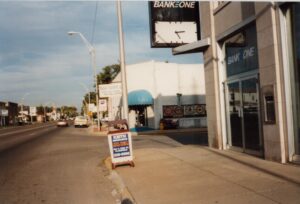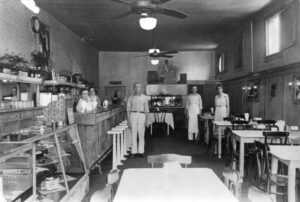The current structure at 101 East Main Street is not the first to stand on that site. As early as 1865, a building owned by Willis Wilhite appears on town maps, though little else is known about it. By 1886, a different building occupied the lot: Dr. Robert M. Lewis maintained a medical office in the front with a dwelling at the rear. By 1893, it had become a boarding house run by Tenie (Christine) Gossett.
In 1901, Leroy Hiatt purchased the property and sold the original building to John Gunn, who relocated it to South Street. In its place, Hiatt constructed the current structure—three adjacent but separate storefronts. Each shop was long and narrow, running from street to back, with individual entrances and no internal access between units. Today, traces of those original entrances can still be seen on the building’s façade.
Early Tenants: Drugstores, Hardware, and the “Hiatt Block”
By the early 1900s, the newly built structure hosted:
Green & Watson Drug Store, replaced by William Simmons Drug Store in 1906
A hardware store in the center
A wallpaper and paint shop on the east end
After Leroy Hiatt’s death in 1910, ownership passed to his wife, Osie Hiatt. In 1909, Reynolds Drug Store vacated (likely from the eastern bay), and a short-lived moving picture show operated by Corey and Kauble took its place. The center unit became home to Robert Black’s furniture store in 1911, while the west unit welcomed the Sanitary Grocery in 1912, later sold to Harry Wilson.
By 1920, a relatively stable configuration had emerged:
East: a movie theater (the Princess Theatre)
Middle: Black’s Furniture
West: a restaurant, beginning its long history as a dining location
Between 1919–1922, the restaurant changed hands five times. In 1922, Jesse Chrisman renamed it the Busy Bee Café, beginning a more recognizable chapter in its life.
The Movie Theater: From Princess to ZaZa
The east bay’s theater proved popular. In one early promotional stunt, a man on a bicycle—allegedly hypnotized—rode in place for 24 hours. By 1920, the venue was named the Princess Theatre, and showed films like Raffles starring John Barrymore.
In 1924, Lowell Prewitt bought the business and renamed it the ZaZa Theatre. It closed in 1927 when Prewitt opened the more modern Prewitt Theatre elsewhere in town.
The Busy Bee Era: Cafés, Fires, and Frequent Changes
The Busy Bee Café name stuck for over a decade despite rapid changes in ownership. In 1924, a fire caused by an oil heater damaged the building but was swiftly extinguished. The restaurant reopened a month later, redecorated and enhanced with new amenities like a refrigerator, electric sign, and ice machine.
Notable transitions include:
1928: E.E. York bought the café
1930: Purchased by O.T. and Julius Hancook
1932–1934: A rapid series of owners, including the Ballard brothers, Clarence Worrell, Roy Almond, and finally A.C. Willis, a seasoned restaurateur.
East Section: French’s Tavern
By 1934, the former ZaZa Theatre space had been converted into French’s Café, operated by Harry French. Originally offering pool tables, the layout was later modified to include private booths, as the café targeted a higher-end clientele.
French expanded his restaurant into the center bay in 1938, merging it with the former furniture store and renaming the establishment French’s Tavern, which sold beer and wine.
Restaurants Merge and Expand (1939–1950s)
In 1939, Jesse Chrisman returned to purchase the former Busy Bee, renaming it Chrisman Café. The café changed hands several more times:
1944: Leonard Knoll, then quickly became Deem’s Café
Later 1944: Renamed Cassell’s Café by J.W. Cassell
1947: Purchased by Edward Dobbels, who added a dairy bar and taxi stand
In 1948, Paul Burch took over French’s Tavern, renaming it Paul’s Place by 1950.
That same year, Alwyn Randall bought Dobbels’ café, and in 1953, he sold it to Ethel and Leo Frederick, who renamed it Frederick’s Café. In 1954, they also leased Paul’s Place, unifying the entire building for the first time under a single restaurant.
Blanton’s & Stacey’s: The Final Restaurant Era
In 1956, William and Ermine Cooper took over, followed in the early 1960s by Edna Blanton, who previously operated the Chicago Inn and Circle Inn. Renowned for her homemade pies, she opened Blanton’s Restaurant, which remained popular until 1972, when Stacey and Emanuel Apostles took over, renaming it Stacey’s Restaurant.
Stacey’s became a beloved local institution, famous for its coffee and cherry cobbler, and moved to a new building at 414 West Main Street in 1979 due to overwhelming popularity.
Return to Retail: Floor Fashions & Beyond
After Stacey’s departure, Lowell and Linda Schroeder purchased the building and opened Floor Fashions, returning the space to its retail roots. Once again, 101 East Main Street hosted shoppers instead of diners.For a more detailed history of this building, be sure to check out Sarah Wright’s book, 50 Historic Buildings of Plainfield, Indiana, available for check-out or purchase.









